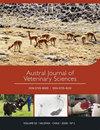The effect of non-traditional cooling on dog sperm cryosurvival and ability to perform the acrosome reaction
IF 0.8
4区 农林科学
Q3 VETERINARY SCIENCES
引用次数: 1
Abstract
Abstract: The objective of this study was to assess cryosurvival, plasma membrane fluidity, and capability of cryopreserved dog (Canis lupus familiaris) spermatozoa, cooled to -5 °C before freezing, to perform the acrosome reaction under the effect of progesterone and calcium ionophore. In the first experiment, fresh spermatozoa diluted in Tyrode’s medium plus albumin, lactate, and pyruvate (TALP) were incubated at 38 °C in 5% CO2 in air, with progesterone or calcium ionophore added at 2, 4, and 6 h after incubation and sampled 30 min later to assess the acrosome reaction. In the second experiment, diluted sperm were packaged in plastic straws, cooled to either +5 °C or -5 °C and cryopreserved. Progressive motility, plasma membrane integrity and fluidity, capacitation status and acrosome integrity were assessed before and after freeze-thawing. After thawing, sperm were assessed, resuspended in TALP and incubated to assess the acrosome reaction. Parameters for sperm cryosurvival were similar in sperm cooled to either +5 °C or -5 °C, except in the percentage of hyper-fluid membranes which was lower (P<0.05) in sperm cooled to -5 °C. There were no differences in the percentages of frozen-thawed spermatozoa with acrosome reaction, induced by progesterone or calcium ionophore, between cooling treatments. In conclusion, cooling of dog spermatozoa to -5 °C did not improve sperm cryosurvival but had a positive effect on plasma membrane fluidity.非传统冷却对犬精子低温存活及顶体反应能力的影响
摘要:本研究旨在研究犬(Canis lupus familiaris)精子冷冻保存后,冷冻前冷却至-5℃,在黄体酮和钙离子载体的作用下进行顶体反应的低温存活、质膜流动性和能力。在第一个实验中,新鲜精子在Tyrode培养基中稀释,加白蛋白、乳酸和丙酮酸(TALP), 38°C, 5% CO2空气中孵育,孵育后2、4和6 h分别加入孕酮或钙离子载体,30 min后取样,评估顶体反应。在第二个实验中,稀释后的精子被包装在塑料吸管中,冷却到+5°C或-5°C并冷冻保存。评估冻融前后的渐进式运动性、质膜完整性和流动性、能化状态和顶体完整性。解冻后,评估精子,在TALP中重悬,孵育以评估顶体反应。在+5°C和-5°C温度下,精子的低温存活参数相似,但在-5°C温度下,超流体膜的百分比较低(P<0.05)。黄体酮和钙离子载体诱导的冻融精子顶体反应的百分比在不同冷却处理之间没有差异。综上所述,将狗精子冷却至-5°C并不能提高精子的冷冻存活率,但对质膜流动性有积极影响。
本文章由计算机程序翻译,如有差异,请以英文原文为准。
求助全文
约1分钟内获得全文
求助全文
来源期刊

Austral Journal of Veterinary Sciences
Veterinary-General Veterinary
CiteScore
1.60
自引率
0.00%
发文量
18
期刊介绍:
Austral Journal of Veterinary Sciences (formerly Archivos de Medicina Veterinaria) publishes original scientific contributions in English, containing the latest developments and discoveries in veterinary sciences. The journal covers topics such as animal health and production, preventive medicine, zoonosis, pharmacology and therapeutics, methods of diagnosis, and other areas related to the veterinary field.
Austral Journal of Veterinary Sciences aims to divulge information about advances in veterinary medicine among universities, research centres, industries, government agencies, biologists, agronomists and veterinarians.
 求助内容:
求助内容: 应助结果提醒方式:
应助结果提醒方式:


